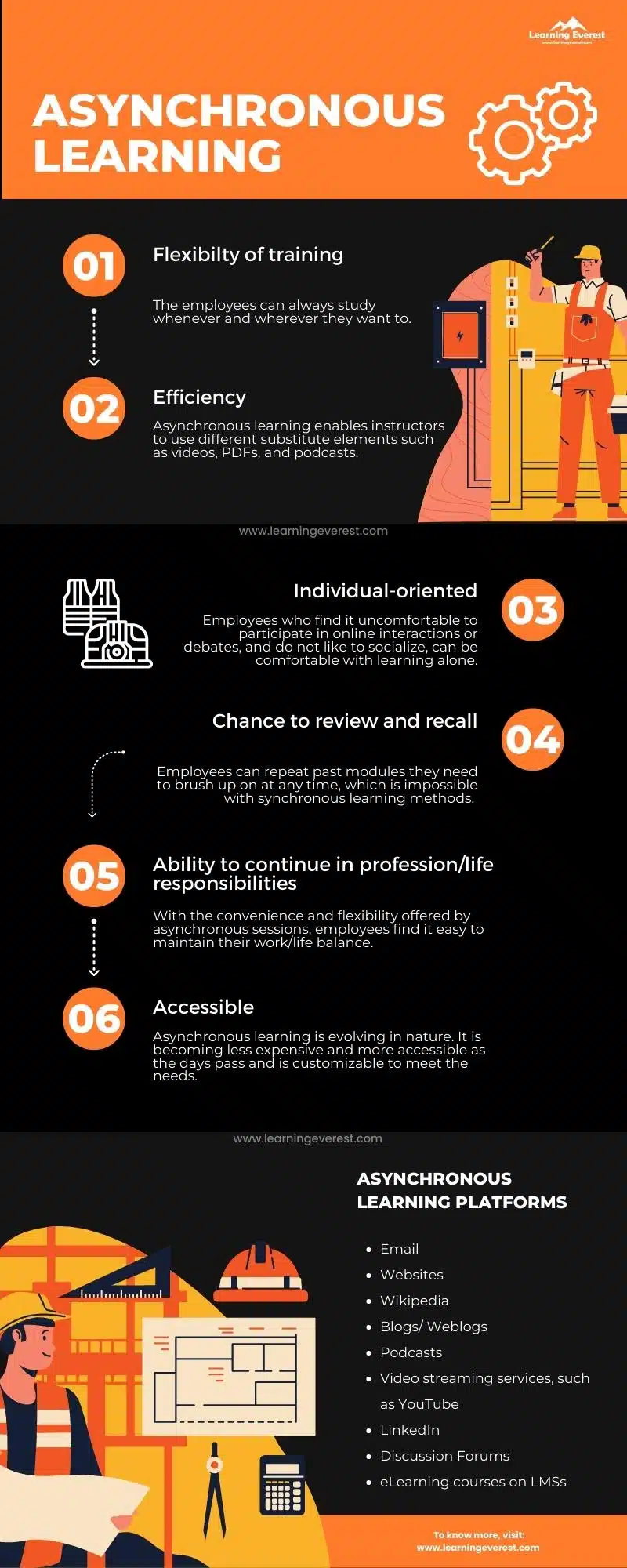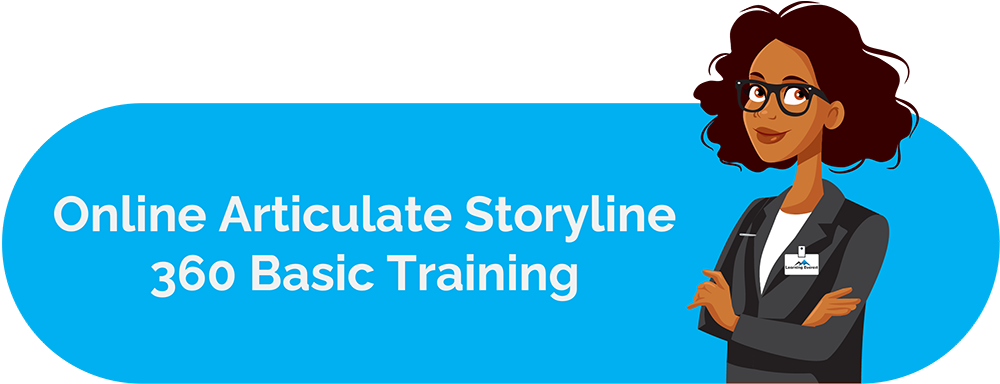With the increasing number of internet users, more people can access e-learning platforms for learning courses or training programs. Employees worldwide are now using online learning to upskill at their jobs at a faster rate. This has affected the e-learning market. The E-learning market reached revenues of over USD 315 billion in 2021 and is projected to observe a 20% CAGR from 2022 to 2028. But why do employees prefer online training to conventional training programs? The flexibility that online training provides is the answer to this question. Online training comes with options to choose from. Whether the learners choose synchronous learning, which involves face-to-face interaction with the instructor, or asynchronous learning. You might be wondering what the second alternative is that allows you to skip face-to-face interactions. What does asynchronous learning mean exactly? Here we will speak a little about what the term asynchronous learning means and as well as discuss its importance in the modern world.
Table of Contents
What does asynchronous learning mean?
The word asynchronous means not in the same real-time. Asynchronous learning means an e-learning method that allows employees to connect and learn at anytime from anywhere. In this type of learning, employees and instructors do not need to engage in course content at the same time. It uses information as a learning mode and delivers them over the net, using database and learning management systems (LMSs).
Who needs asynchronous learning?
A wide range of different organizations, from learning institutions to large corporations, can benefit from using a learning management system by reducing expenses for things like transport and accommodations, instructors’ salaries, and learning materials. Well-align asynchronous learning helps organizations to save time and money, overcome learning goals, set a structured learning and training environment, and assess and develop employees’ knowledge regularly. Therefore, organizations that need to improve the learning and development environment require asynchronous learning for their employees.
Asynchronous learning platforms
The following platforms allow employees to get this type of learning:
- Websites
- Wikipedia
- Blogs/ Weblogs
- Podcasts
- Video streaming services, such as YouTube
- Discussion Forums
- Courses on learning platforms (Coursera, Udemy, Unacademy, Skillshare, Shaw Academy, etc.)
- Microlearning
- E-learning courses on Learning Management Systems (LMSs)
Advantages of online asynchronous learning
Asynchronous learning has the following advantages:
- Flexibility: The employees can always learn whenever and wherever they want to. Asynchronous learning can allow employees to use unique tools, expertise, and course content that would otherwise not be available. It makes it easier for employees who struggle in the classroom due to physical limitations or learning difficulties to engage in training school.
- Pace flexibility: It help employees undertake the courses at their own pace, according to their own needs. This gives the employees freedom in their choices.
- Chance to review and recall: Employees can repeat past lectures they need to brush up on at any time, which is impossible with synchronous learning methods. This is a massive advantage on the part of the employees. This allows employees to remember and relearn the materials at their convenience.
- An abundance of material: There is an opportunity to review outside resources to aid instruction. One can explore the extensive internet resources of a variety of programs and courses online, and thanks to schedule flexibility and the breaking down of classroom walls, one can use them in their career advancement by improving technical skills.
- Individual-oriented: The asynchronous learning method might not offer a setting that fosters social skills development. But employees who find it uncomfortable to participate in online interactions or debates, and do not like to socialize, can be comfortable with learning alone on their own. By providing individualized programs, asynchronous learning gives a safe environment to them.
- Ability to continue in profession/life responsibilities: With the convenience and flexibility offered by asynchronous classes, employees find it easy to maintain their work/life balance.
- Efficiency: Asynchronous learning enables instructors to use different substitute elements such as videos, PDFs, and podcasts. Instructors can use these tools as part of their lessons. Employees can access the resources, be it notes, theories, diagrams, or PPTs, from anywhere and at any time of the day.
- Accessible: Asynchronous learning is evolving in nature. It is becoming less expensive and more accessible as the days pass and is customizable to meet the needs of any organization. This allows employers to make this training structure easily accessible to employees across their organization, resulting in more people learning and qualifying for promotions.
- Cost-effective: With no transportation costs and resources available online, asynchronous learnings are a more cost-effective solution than the traditional learning technique.
- Higher retention: Using digital resources, including presentations and multimedia that includes images, videos, and audio, employees get to learn more than any traditional learning method.
- Avoids commuting: Employees do not have to worry about transportation with asynchronous learning. The learnings are available at any time and in any place. Therefore, they save much time and money on online training.
Disadvantages of online asynchronous learning
This type of learning can have some downsides as well.
- Lack of motivation: The lack of personal one-on-one engagement with trained and qualified instructors throughout the course might contribute to some employees’ lack of enthusiasm. Therefore, asynchronous learning requires a lot of self-discipline on the part of employees.
- Disadvantages of self-paced format: Not all instructions are suited for self-paced learning. So, it might become difficult for a few employees to comprehend the course independently.
- Lack of immediate response: Some modes of asynchronous learning might not provide immediate feedback, such as passive learning from YouTube videos. But a variety of platforms do offer employees instant feedback that helps them evaluate their growth and motivates them. The feedback is provided by their fellow online employees or the platform itself. Tests conducted through online quizzes or some pre-designed software provide the employees with immediate response or feedback.
Tips to keep employees engaged in an asynchronous learning environment
It requires employees to be actively involved and take more responsibility for asynchronous learning. Therefore, there is a necessity for a few special requirements for an asynchronous course.
- Different responsibilities: The instructor must take on multiple new roles. The constructivist theory that supports asynchronous class learning demands that instructors become more than dispensers of knowledge; it requires that they become instructional designers, facilitators, and assessors of both grades and their teaching methods.
- New tools: Asynchronous learning is tool-based. Therefore, allow employees time to acquire new tools in low-stakes activities. Giving them time to explore will build their confidence with the device and help them in future projects.
- Break it up: Asynchronous learning is not the same as synchronous learning. Therefore, instructors should not design classes in the same way. Breaking up the lesson into chunks and delivering short lessons allow employees to learn independently or in digital groups.
- Add variety: Add a variety of instruction methods to suit the needs of different types of learning styles. Design the modules to bring in variety so that the learner remains engaged and immersed in the modules.
- Make it interactive: In the absence of a live facilitator, the employees needed to remain interested throughout the course. To get employees to participate in classes, begin with a warm-up activity. Use online breakout rooms, collaborative whiteboards, and embedding games to allow employees to collaborate.
- Take breaks: Break things up with creative exercises and activities. More than 45 minutes of screen time in one sitting can be hard on the eyes and mind. Let the employees take screen-free breaks to reset the mind and the body.
Infographics

What does asynchronous learning mean
Conclusion
It is definite that with the help of growing technologies, this self-paced mode of asynchronous class can be the ultimate way of future learning. Using technology, employees can upskill their knowledge as well as control their learning journey. However, there is also a necessity for a personal touch from a knowledgeable and experienced individual from time to time, which is now also available in the asynchronous learning method. The inclusion of personalization, however, makes asynchronous classes more desirable to modern employees in a busy, fast-paced world. Therefore, the ideal strategy is to choose the appropriate tools, technology, and resources to get the most impact from the learning journey.
Frequently Asked Questions (FAQs)
What does asynchronous mean?
The word asynchronous means not in the same real-time.
What does asynchronous learning mean?
Asynchronous learning means an e-learning method that allows employees to connect and learn at anytime from anywhere. In asynchronous learning, employees and instructors do not need to engage in course content at the same time.
What is an example of asynchronous learning?
An example of asynchronous learning is learning from eLearning courses on an LMS.
Why is asynchronous learning good?
The employees can always study whenever and wherever they want to. Asynchronous learning can allow employees to use unique tools, expertise, and course content that would otherwise not be available.





